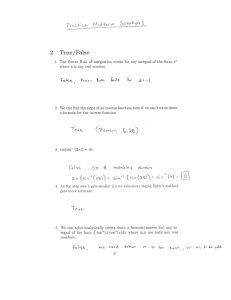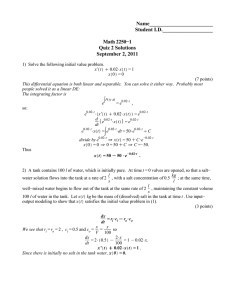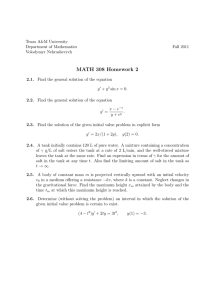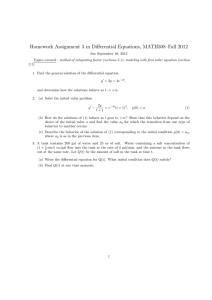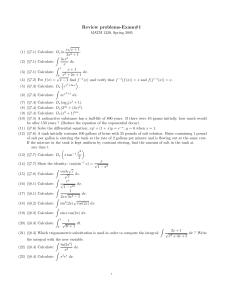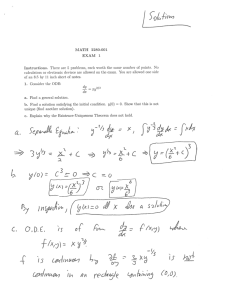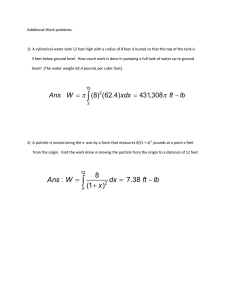Homework #2 - UC Davis Mathematics
advertisement
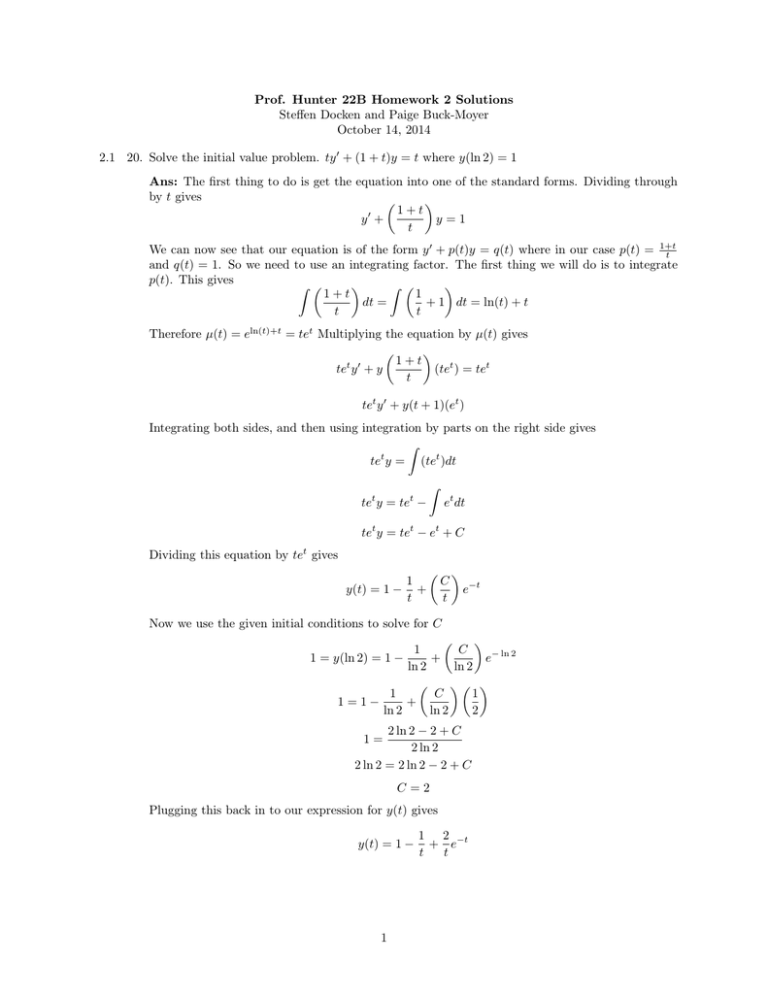
Prof. Hunter 22B Homework 2 Solutions Steffen Docken and Paige Buck-Moyer October 14, 2014 2.1 20. Solve the initial value problem. ty 0 + (1 + t)y = t where y(ln 2) = 1 Ans: The first thing to do is get the equation into one of the standard forms. Dividing through by t gives 1+t 0 y + y=1 t We can now see that our equation is of the form y 0 + p(t)y = q(t) where in our case p(t) = 1+t t and q(t) = 1. So we need to use an integrating factor. The first thing we will do is to integrate p(t). This gives Z Z 1+t 1 dt = + 1 dt = ln(t) + t t t Therefore µ(t) = eln(t)+t = tet Multiplying the equation by µ(t) gives 1+t t 0 (tet ) = tet te y + y t tet y 0 + y(t + 1)(et ) Integrating both sides, and then using integration by parts on the right side gives Z tet y = (tet )dt tet y = tet − Z et dt tet y = tet − et + C Dividing this equation by tet gives 1 y(t) = 1 − + t C t e−t Now we use the given initial conditions to solve for C 1 C + e− ln 2 ln 2 ln 2 1 C 1 + 1=1− ln 2 ln 2 2 1 = y(ln 2) = 1 − 2 ln 2 − 2 + C 2 ln 2 2 ln 2 = 2 ln 2 − 2 + C 1= C=2 Plugging this back in to our expression for y(t) gives y(t) = 1 − 1 1 2 −t + e t t 33. Show that if a and λ are positive constants, and b is any real number, then every solution of the equation y 0 + ay = be−λt has the property that y → 0 as t → ∞. Ans: We will split this into two cases, a = λ and a 6= λ. First, for a = λ we have y 0 + ay = be−at R Let µ(t) be an integrating factor. Then µ(t) = exp adt = eat . Multiplying the equation by µ(t) gives eat y 0 + aeat y = be−at eat or eat y 0 =b Therefore, integrating both sides gives eat y = bt + C, where C is a constant. So, y(t) = e−at (bt + C) Also, since a > 0, the exponential is a decaying exponential, and y(t) → 0 as t → ∞, because the exponential decays faster than the linear term grows. Now, for a 6= λ, we again have µ(t) = eat as an integrating factor. But when we multiply through by µ(t), we get eat y 0 + aeat y = be−λt eat = be(−λ+a)t or eat y 0 = be(a−λ)t Integrating both sides gives eat y = be(a−λ)t +C a−λ where C is a constant. So, y(t) = be(a−λ−a)t be−λt + Ce−at = + Ce−at a−λ a−λ Therefore, y(t) → 0 as t → ∞, since a, λ > 0, meaning y(t) is the sum of two decaying exponentials. 2.2 4. Solve the differential equation y 0 = (3x2 − 1)/(3 + 2y) Ans: Separating the variables gives (3 + 2y)dy = (3x2 − 1)dx and integrating both sides gives Z Z (3 + 2y)dy = (3x2 − 1)dx 3y + y 2 9 y 2 + 3y + 4 2 3 y+ 2 3 y+ 2 y = x3 − x + C = x3 − x + C + 9 = x3 − x + C 4 = x3 − x + C = x3 − x + C 21 = x3 − x + C 21 2 − 3 2 the 9 4 is absorbed into C 21. Solve the initial value problem y 0 = (1 + 3x2 )/(3y 2 − 6y), y(0) = 1 and determine the interval in which the solution is valid. Ans: Separating the variables gives (3y 2 − 6y)dy = (1 + 3x2 )dx and integrating both sides gives Z Z 2 3y − 6ydy = 1 + 3x2 dx y 3 − 3y 2 y − 3y − x3 − x 3 2 = x + x3 + C = C Now, plugging in the initial condition gives 13 −3(1)2 −03 −0 = C, so C = −2 and y 3 −3y 2 −x3 −x = −2 is the solution. A graph of the solution is given below. The integral curve becomes vertical at x = 1, so the interval in which the solution is valid is [0, 1). 2.3 2. A tank initially contains 120L of pure water. A solution of γg/L of salt water enters the tank at 2L/min and the well mixed solution flows out of the tank at the same rate. Find an expression in terms of γ for the amount of salt in the tank. Also, find the limiting amout of salt in the tank as t → ∞. Ans: Let y(t) denote the amount of salt present in the tank at time t. To describe y 0 we need to determine the change in the amount of salt in the tank. The change in salt in the tank, y 0 , is given by y 0 = (grams of salt coming into the tank) - (grams of salt leaving the tank) For salt flowing into the tank we have 2γg 2L γg = min L min For salt flowing out of the tank we have 2L y(t)g y(t)g = min 120L 60min 3 This is because to get the total amount of salt flowing out we multiply the amount of solution flowing out of the tank my the concentration of salt in that solution. This gives us the differential equation y y 0 = 2γ − 60 To solve this we can separate variables. 120γ − y 60 60 dy = 1dt 120γ − y y0 = Integrating both sides gives Z 60 1 120γ − y Z dy = 1dt −60 ln(120γ − y) = t + C ln(120γ − y) = −t +C 60 Exponentiating gives −t 120γ − y = Ce 60 −t y(t) = Ce 60 + 120γ Now we can use out initial data to solve for C. We know that at time t = 0 there is no salt in the tank. This gives us the condition y(0) = 0 Substituting this in gives 0 y(0) = 0 = Ce 60 + 120γ 0 = C + 120γ C = −120γ −t Replacing C with this value in our expression for y(t) gives us y(t) = 120γ(−e 60 + 1) Now we need to find the limiting amount of salt in the tank. This is found by finding the value of y(t) where there is no change in the amount of salt. In other words, the value of y(t) where y 0 = 0. Using our differential equation y0 = Setting y 0 = 0 120γ − y 60 120γ − y 60 0 = 120γ − y 0= y = 120γ This is our limiting value for y(t) 20. A ball with mass 0.15kg is thrown upward with initial velocity 20m/s from the roof of a building 30m high. Neglect air resistance. (a) Find the maximum height above the ground that the ball reaches. Ans: Let y be the height of the ball above the ground. Then our differential equation comes from Newton’s law of motion F = ma, and F = −mg is just the force due to gravity. So, the differential equation is my 00 = −mg, or y 00 = −g 4 and the initial conditions y(0) = 30m and y 0 (0) = 20m/s. Integrating both sides twice gives Z Z Z Z d dy dtdt = − gdtdt dtZdt Z dy dt = − gt + adt dt 1 y = − gt2 + at + b 2 Now plugging in the first initial condition gives 30m = y(0) = − 12 g(0)2 + a(0) + b, which means that b = 30m. Taking the derivative gives y 0 = −gt + a, so plugging in the second initial condition gives 20m/s = y 0 (0) = −g(0) + a, which gives a = 20m/s. So, the height of the ball at time t is given by 1 y(t) = − gt2 + (20m/s)t + 30m 2 Now, the ball reaches its maximum height when its velocity changes sign, or when y 0 = 0. Taking the derivative gives y 0 = −gt + 20m/s. So, y 0 = 0 at t = 20m/s , and g ymax 20m/s ) g 2 20m/s 20m/s 1 + 20m/s + 30m − g 2 g g 400m2 /s2 400m2 /s2 − + + 30m 2g g 400m2 /s2 + 30m 2g 50.4m = y( = = = ≈ using g = 9.8m/s2 . (b) Assuming that the ball misses the building on the way down, find the time that it hits the ground. Ans: For our coordinate system, the ground is at y = 0, so the ball hits the ground at a time t, such that 0 = y(t) = − 21 gt2 + (20m/s)t + 30m. Solving for t gives t = ≈ −20m/s ± p −1.17s, 5.25s Since t must be larger than 0, t ≈ 5.25s. 5 400m2 /s2 + g60m −g (c) Plot the graphs of velocity and position versus time. The graph of the position versus time is And the graph of the velocity versus time is 6
